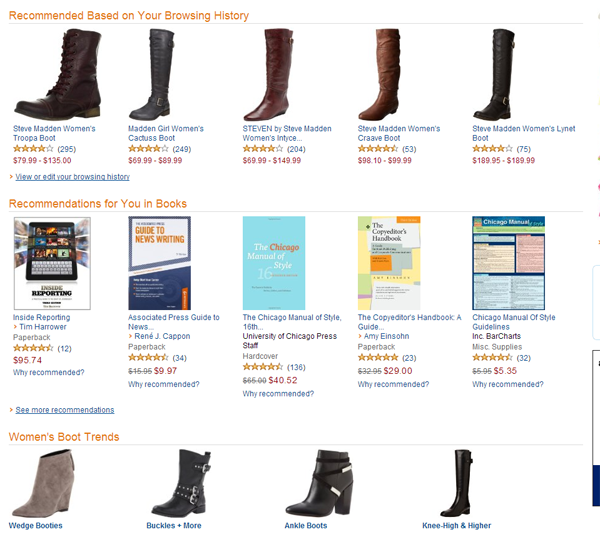How to Beat Amazon at Its Own Game

It's clear that consumers' expectations are driving companies to launch personalization efforts and for many big retailers, product recommendations are a great place to start. In the beginning, many brands turn to SKU-based rules. Consumers see a lot of "customers who about this also bought that" or "shoppers who viewed this also view that" features on popular ecommerce sites. But experts like Nate Barad, the director of product strategy at Sitecore, think these rules are missing the "who" in recommendations. Barad asks what if a customer has already bought "this" and "that"? Good question.
This is where Amazon (sigh) really shines. Baynote VP of Marketing and Development Dan Darnell recommends running an experiment of sorts at Amazon.com by seeing what information it pulls from your past behaviors. (Go ahead, we'll wait.) This editor recently searched for women's boots, but left without purchasing. This editor did, however, purchase, "The Associated Press Stylebook." So, rather than showing me the AP Stylebook again, Amazon features complementary items and also includes, "Women's Boot Trends," because I could still be in the market for boots.

Additionally, Amazon updates personalization in milliseconds for related items you've viewed, more items to consider, inspired by your browsing history and more. If a shopper doesn't want something that was related to what he or she purchased before, they will likely use on-site search to find what he or she does want. As the shopper shows intent, Amazon will grab onto that information and use it to show contextual products. They show alternatives, what to consider, what people are buying to be successful with a product and more.
Most big brands don't have a fraction of that personalization/recommendation engine working for their enterprises. Personalization is polluted even more when brick-and-mortar locations are part of the ecommerce equation. More often than not, the buying experience is similar to this scenario... A consumer buys a product (any product really) in a retail store, goes home and logs onto the retailer's website and the first thing they see is advertising for the product they just bought. Why would I want an iPad Mini if I just bought one at the Apple store in the mall? It's not only somewhat offensive to the shopper but also a missed opportunity to further brand loyalty with a promotion for accessories or complementary items. From a tech perspective, nothing should prevent retailers from offering a better, more personalized user experience.
The problem is, many legacy systems aren't communicating customer intelligence to each other. And while it's clear that marketers understand the importance of personalization (94 percent of companies agree that it's critical to current and future success according to econsultancy), more than half of companies are not personalizing the Web experience for visitors. Misconceptions, costs and IT integration are three top reasons why.
Brands can beat Amazon at its own game by implementing personalization solutions that consider the "who" in the recommendations and are truly enterprise ready. Here are a few suggested offerings (in no particular order):
1. Sitecore
2. Baynote
3. Monetate
4. RichRelevance
5. Adobe Target
Bonus: Don't forget about retargeting when trying to compete with Amazon. After searching for this watch (see image) on Amazon, sure enough this ad was delivered the next day:









